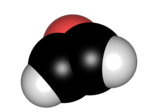Oxirene
Oxirene is a hypothesized heterocyclic chemical compound which contains an unsaturated three-membered ring containing two carbon atoms and one oxygen atom. Because it has never been observed, the substance is mainly studied by quantum chemical computational techniques. As the configuration is extremely strained and proposed to be an anti-aromatic 4 π electron system, oxirene is expected to be very high energy and unstable according to these calculations. Moreover, different computational methods draw different conclusions as to whether the structure constitutes a true molecule (i.e., a local minimum on the potential energy surface) or merely a transition state between two isomeric molecular species.[2][3]
| |||
 | |||
| Names | |||
|---|---|---|---|
| Preferred IUPAC name
Oxirene[1] | |||
| Systematic IUPAC name
Oxacyclopropene | |||
| Other names
Epoxyethene Ethyne oxide Acetylene oxide | |||
| Identifiers | |||
3D model (JSmol) |
|||
| ChEBI | |||
| ChemSpider | |||
| MeSH | C012469 | ||
PubChem CID |
|||
CompTox Dashboard (EPA) |
|||
| |||
| |||
| Properties | |||
| C2H2O | |||
| Molar mass | 42.04 g/mol | ||
| Related compounds | |||
Related molecules with 3-membered rings |
Ethylene oxide cyclopropane cyclopropene aziridine thiirane thiirene | ||
Except where otherwise noted, data are given for materials in their standard state (at 25 °C [77 °F], 100 kPa). | |||
| Infobox references | |||
Experimental indications exist that substituted oxirenes (as intermediates or transition states) may be involved in carbonylcarbene rearrangements observed in the Wolff rearrangement.[4] Computational evidence also point to the intermediacy of oxirenes in the ozonolysis of alkynes.[5]
References
- "Front Matter". Nomenclature of Organic Chemistry : IUPAC Recommendations and Preferred Names 2013 (Blue Book). Cambridge: The Royal Society of Chemistry. 2014. p. 146. doi:10.1039/9781849733069-FP001. ISBN 978-0-85404-182-4.
- Mawhinney, Robert C; Goddard, John D (2003). "Assessment of density functional theory for the prediction of the nature of the oxirene stationary point". Journal of Molecular Structure: THEOCHEM. 629 (1–3): 263–270. doi:10.1016/S0166-1280(03)00198-2.
- Lewars, Errol G. (2011). Computational Chemistry - Introduction to the Theory and Applications of Molecular and Quantum Mechanics (2nd ed.). Springer. doi:10.1007/978-90-481-3862-3. ISBN 978-90-481-3862-3.
- Kirmse, Wolfgang (2002). "100 Years of the Wolff Rearrangement". European Journal of Organic Chemistry. 2002 (14): 2193–2256. doi:10.1002/1099-0690(200207)2002:14<2193::AID-EJOC2193>3.0.CO;2-D.
- Cremer, Dieter; Crehuet, Ramon; Anglada, Josep (June 2001). "The Ozonolysis of AcetyleneA Quantum Chemical Investigation". Journal of the American Chemical Society. 123 (25): 6127–6141. doi:10.1021/ja010166f. ISSN 0002-7863. PMID 11414847.

